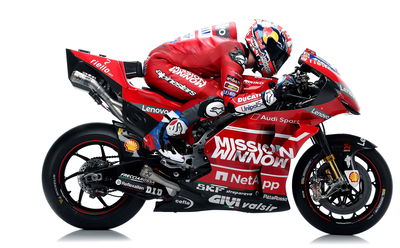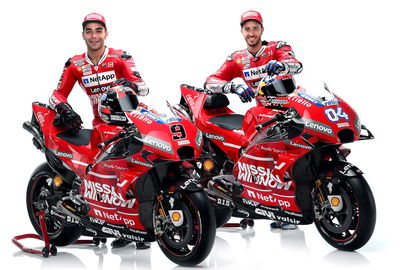'Massive CFD use' part of Ducati aero push
During the 2014 season, MotoGP development was broadly grouped into three areas - engine, chassis and electronics.
But the appearance of winglets on the front of the Ducati during 2015 pre-season testing kicked off a 'fourth dimension' of performance; aerodynamics.
Winglets had been seen before in 500cc/MotoGP, but never really caught on.
This time was different. Aided by engineers with F1 experience and using the latest aerodynamic modelling, Ducati were eventually able to produce effective levels of downforce at every circuit.

During the 2014 season, MotoGP development was broadly grouped into three areas - engine, chassis and electronics.
But the appearance of winglets on the front of the Ducati during 2015 pre-season testing kicked off a 'fourth dimension' of performance; aerodynamics.
Winglets had been seen before in 500cc/MotoGP, but never really caught on.
This time was different. Aided by engineers with F1 experience and using the latest aerodynamic modelling, Ducati were eventually able to produce effective levels of downforce at every circuit.
And when MotoGP moved to unified ECU software in 2016, the anti-wheelie value of the downforce became even more attractive, with wings soon sprouting from the front of rival machines.
The clampdown - on safety grounds, a claim fiercely challenged by Ducati - came for 2017, when normal 'protruding' wings were banned. But the door was left open for any downforce devices that could be 'integrated' into the fairing. Fairing updates were also limited to one per the season.
Technical Director Danny Aldridge was the sole judge of compliance with the new aerodynamic rules, prompting an escalating series of designs as manufacturers re-configured or exaggerated parts of previously accepted fairings.
The most controversial practice was the use of 'modular' fairings, which were homologated in maximum downforce specification but could legally be broken down and used in several smaller stages. So 'one' fairing design could behave like two, three or even four different fairings.
In came another set of rules for 2019, which ends the practice of modular fairings and also spells out precise dimensions (a box) within which the downforce features must fit.
"From the aerodynamic point of view, the 2019 regulations are certainly more restrictive, both because they prevent the modularity of the fairing, the possibility to apply or move parts on the fairing," said Ducati Corse general manager Gigi Dall’Igna, during Friday's team launch in Switzerland.
"And because they also restricted the size of the fairing. I expect the aerodynamic load will be slightly lower than on the 2018 bike.
"However, I hope that after having changed the aerodynamic regulations for two years in a row, now we have arrived at the stability of rules, which is the only possible cost-saving method in MotoGP."
Edoardo Lenoci is now talking aerodynamics, confirms Ducati use a lot of CFD to model aero followed by wind tunnel work.
— CRASH.NET/MotoGP (@crash_motogp) January 18, 2019
►https://t.co/7CYXUcMsEU
#ForzaDucati #MotoGP pic.twitter.com/wA5wpDaWJg
In a new move, Ducati also invited its Aerodynamic Development manager Edoardo Lenoci on stage at the team launch.
"When I started to work in Ducati six years ago, my background and experience was based on F1," Lenoci said. "So you can see that for example, in Formula One there is a lot of money invested in aerodynamics development.
"What we've learned from that world and transferred to my experience here at Ducati was a different approach in terms of for example using specific tools, so identifying the correct tools and using them in a proper way."
In simple terms, Aerodynamic development falls into two categories; 'reality' (wind tunnel and track testing) and 'virtual reality' (computer simulations, CFD).
It is the latter which Ducati said it has exploited most for the new generation of MotoGP aerodynamics, with wind tunnel work used to fine-tune final designs.
"We introduced massive use of CFD, which is Computational Fluid Dynamics, that means the mathematical simulation of what happens around the bike in terms of aerodynamics," said Lenoci.
"In the past we used to develop bikes in the wind tunnel, so we used a full-scale model, made up of actual existing components, spare parts from existing bikes for example.
"By using the CFD, there are a couple of advantages, for example I can tell you on one side the huge amount of data coming out of simulations helps the engineers to understand with deep knowledge what happens on the bike in terms of aerodynamics.
"Because in the wind tunnel you cannot see pressure distribution or streamlines or stress distributions on the surface of the bike. While you have this in CFD. So when you go in the wind tunnel you just do optimisation work, which is as important as developing new concepts.
"On the other side you don’t have to wait for existing parts to be mounted on the bike as a model, so you can start your development earlier than before."
But it's not just a case of plugging in lots of computers, the difficult part is setting up and using a CFD package so that the results correlate accurately with what actually happens when on the race track (the same applies to wind tunnels), otherwise all the pretty diagrams generated have little meaning.
Numerous different mathematical equations can be chosen to simulate the unsteady and random nature of turbulent air flow, for example.
Another aero image from the Ducati launch.
— CRASH.NET/MotoGP (@crash_motogp) January 18, 2019
►https://t.co/7CYXUcMsEU
#ForzaDucati #MotoGP pic.twitter.com/iTh3ztjlRu
Asked how it felt to see the other MotoGP manufacturers forced to follow Ducati's lead and invest heavily in downforce fairings, Lenoci replied:
"Well, if you look maybe five years ago at a starting grid during a MotoGP race you would see all the bodywork of our competitors looked quite similar. And maybe some of them had not changed for years.
"Then in recent years a lot of aerodynamic details started to be mounted, even on our competitors bikes - strange appendages and stuff like that. And even depending on the rider.
"On one side, I can tell you that we are happy about that, because we started at the very beginning and maybe we were right in doing that investment of money and time.
"On the other side this is also motivating for us, because it gives you the pressure to push a little bit forward the level of development and new ideas to come."
Turning to the stricter 2019 regulations, Lenoci has faith that Ducati's aerodynamic methodology will meet any future challenges.
"As Gigi mentioned, the regulations have been changed in the last two years in terms of what was available and possible in terms of making new aerodynamics," he said.
"For sure as engineers, we would like that these kind of changes would have been aimed at improving the performance, but sometimes this is not the case so it's just a matter of reducing or limiting, for example for cost reductions, as happened before.
"My opinion is that there are so many areas to be explored in terms aerodynamics and in any case our methodology we are going to use will be the same and will allow us to take the chance to face the new challenges no matter where they come from."
Ducati's 2019 fairing was not shown at the team launch and will remain under wraps until the final pre-season test.
"In Qatar, immediately before the opening race of the season, we will test the new fairing, as usual," Dall’Igna said.












